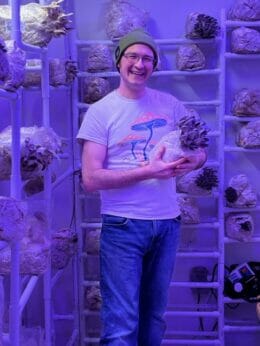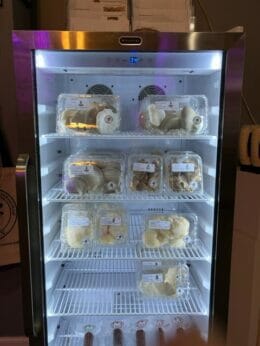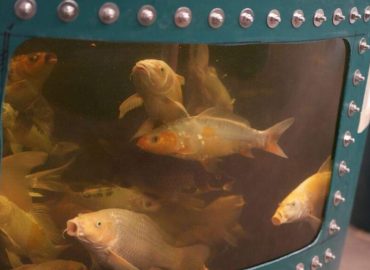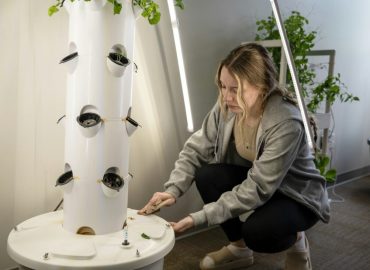Small Scale Mushroom Farming

Could New York Become the Mushroom State?
Small Scale Mushroom Farming | Sara Foss |
On the banks of the Hudson River in Troy, NY, there’s an unassuming forest-green building, tucked between a used-car lot and towing business. This refurbished auto-body shop fits right into the neighborhood of commercial buildings. There are no open fields or garden beds thick with produce. But step inside and everything changes. You’ve found Collar City Mushrooms.
Colorful paintings by local artists hang on the walls. There are reference books such as “Medicinal Mushrooms: An Essential Guide” and recipes for dishes such as Smoky Spanish Style Oyster Mushrooms. A stuffed gnome sits on a window sill.
The refrigerated display case is where buyers can find Collar City’s crop: the specialty mushrooms produced in its three climate-controlled grow rooms.
Each room houses vertical racks, lined with brown blocks of substrate that provide the nutrition and energy mushrooms require to grow and fruit. Just 320 square feet in total, the grow rooms yield approximately 150 pounds of mushrooms per week. At any given moment, a half-dozen different kinds of mushrooms are in production.
“We have mountains of mushrooms right now,” Avery Stempel, owner of Collar City, informs a customer eyeing the oyster, shiitake, lion’s mane and king trumpets in the case. “Want me to put a mix together?”

Image: Avery Stempel, co-owner of Collar City Mushrooms, shows off some of the mushrooms in his grow room. Photography by Sara Foss.
Collar City, established in 2020 by Stempel and his partner, Amy Hood, is premised on the idea that to know mushrooms is to love them. However, most Americans need a better introduction to the wide diversity of edible fungi species, many of which can be found in their own backyards. Stempel and Hood, for instance, began loving mushrooms through foraging.
“I would go to the forest, and finding that splash of color, the mysterious mushroom that just suddenly appeared, was always fascinating to me,” says Stempel. “When Amy and I got together, one of the things that connected us was our phones were filled with pictures of mushrooms.” After the two dated for a little while, they began talking about starting a mushroom farm.
It was mostly a pipe dream —until Stempel was furloughed from his job at a performing arts center early in the pandemic. “I thought, ‘Maybe this is the catalyst I need to start the mushroom farm,’” he says.
Now, Collar City is selling mushrooms to about 20 restaurants and has plans to double its operations, to 300 pounds from 150 pounds per week in 2023. Other goals include building a grow room in the basement, a bar and a stage for performances and a commercial kitchen.
In starting their company, Stempel and Hood were ahead of the mushroom curve. The New York Times declared the mushroom 2022’s ingredient of the year, observing that the number of “small urban farms growing mushrooms is expected to bloom.” The buzz was warranted, but most of the mushrooms consumed in the U.S. still come from a single, commercially produced species, Agaricus bisporus. These mushrooms take several forms familiar to anyone who eats pizza or salad: button, brown and portobello.
Specialty mushrooms—defined as any mushroom not belonging to the genus Agaricus—are a small but emerging niche, one that Stempel and others hope to cultivate and usher into the mainstream.
Steve Gabriel, specialty mushrooms and agroforestry specialist for the Cornell Small Farms Program in central New York, began teaching outdoor growers to cultivate shiitake mushrooms about a decade ago. Interest skyrocketed, and Cornell began working with indoor farmers about two years ago, in response to grower demand. “People kept asking about it,” says Gabriel.
“People are super-hyped for specialty mushrooms,” says Devon Gilroy, owner of Tivoli Mushrooms in the small city of Hudson, N.Y., about 50 miles south of Troy. “The problem is that the mushrooms you see at the grocery store are dying in little plastic bags.”
Established six years ago in a former chair factory on the banks of the Hudson River, Tivoli Mushrooms is in the midst of a major expansion. The farm currently produces about 1,000 pounds of mushrooms per week. A larger building will enable Tivoli to exponentially boost production, to between 12,000 to 15,000 pounds of mushrooms per week. “Nobody in New York State is going all in on specialty mushrooms like we are,” says Gilroy, who sells to restaurants, markets and apothecaries.
Gilroy is also looking to tap into the booming market for what’s known as “functional mushrooms,” coveted for benefits such as enhanced immunity, better brain function and relief from inflammation, and a key ingredient in wellness products such as powders and teas. He recently launched a sister company, Go Mushrooms, that manufactures medicinal tinctures.
California and Pennsylvania are the biggest producers of U.S. mushrooms, with the Keystone State accounting for 66% of the total volume of sales, according to the USDA. Still, New York growers are optimistic about New York’s potential to become a bigger player, specifically in the specialty market.
They point to the state’s abundance of protected forests, where conditions for outdoor growing on inoculated logs are ideal, and the possibilities opened up by indoor, vertical farming. Especially well positioned to tap into the burgeoning appetite for gourmet mushrooms in New York City and the lower Hudson Valley are farmers in the eastern part of the state.
“If you can grow mushrooms, you can sell them,” says Gabriel. “It’s not hard. There’s a demand.”
The value of sales for commercially grown specialty mushrooms jumped 32% in 2021-2022, to $87.3 million, according to the United States Department of Agriculture. This surge occurred even as the value of the Agaricus crop, estimated at $931 million, fell 7% from the previous season.
Gabriel estimates that there are at least 500 specialty mushroom growers in the U.S., with about 100 in New York, but it’s tough for many of them to enter the business full time. It’s also difficult to get an accurate picture of how many people are growing specialty mushrooms, because of the USDA’s focus on larger farms in select states.
“The vast majority of folks are doing this as a side hustle,” says Gabriel. “Most of the farms down in Pennsylvania are grossing $1 million a year or more. That’s very different from the audience we’re working with at Cornell.” About one-quarter of the farmers surveyed by Cornell “produce over 100 pounds of mushrooms a week, and the rest produce under 100 pounds. It’s bringing in income, but it’s not $1 million a year.”

Image: The stock at Collar City Mushrooms is dried or kept refrigerated for customers. Photography by Sara Foss.
In 2012, Gabriel started his own mushroom farm, Wellspring Forest Farm, in New York’s Finger Lakes region. In the beginning, he grew shiitake in the woods, putting into practice the agroforestry practices he espoused at Cornell and in classes offered at Wellspring. When robust demand for his mushrooms sparked thoughts of expansion, he realized the best way to scale up was indoors. Now Wellspring produces oysters, lion’s mane and king oyster mushrooms in a building constructed for that purpose.
“There were only so many logs we could schlep around,” says Gabriel. “If you really want to make a sizable income from mushroom growing, it’s a much easier transition if you have some indoor capacity.”
From his vantage point at the Cornell Small Farms Program, Gabriel sees big things ahead for specialty mushrooms. In New York, the increase in the number of growers has outpaced other states. But whether the state becomes known for specialty mushroom production depends in part on whether its agricultural leaders find ways to make it easier for would-be growers to get started and expand, such as loosening the rules around turning fresh mushrooms into value-added products such as powders or foods.
“In some states, like Maine and Vermont, you can do a lot of that stuff in your kitchen, until you gross more than $10,000 in sales or sell more than 100,000 units,” says Gabriel. “If I want to dry my mushrooms, I’ve got to rent a commercial kitchen and dry them there.”
“The grower interest is there,” says Gabriel, adding that, with state-supported regulations, the community will continue to expand. “We have another several decades of being on the upswing of the curve.”
Original Article: https://modernfarmer.com/2023/01/mushroom-state-new-york/
The post Small Scale Mushroom Farming appeared first on GROZINE.



